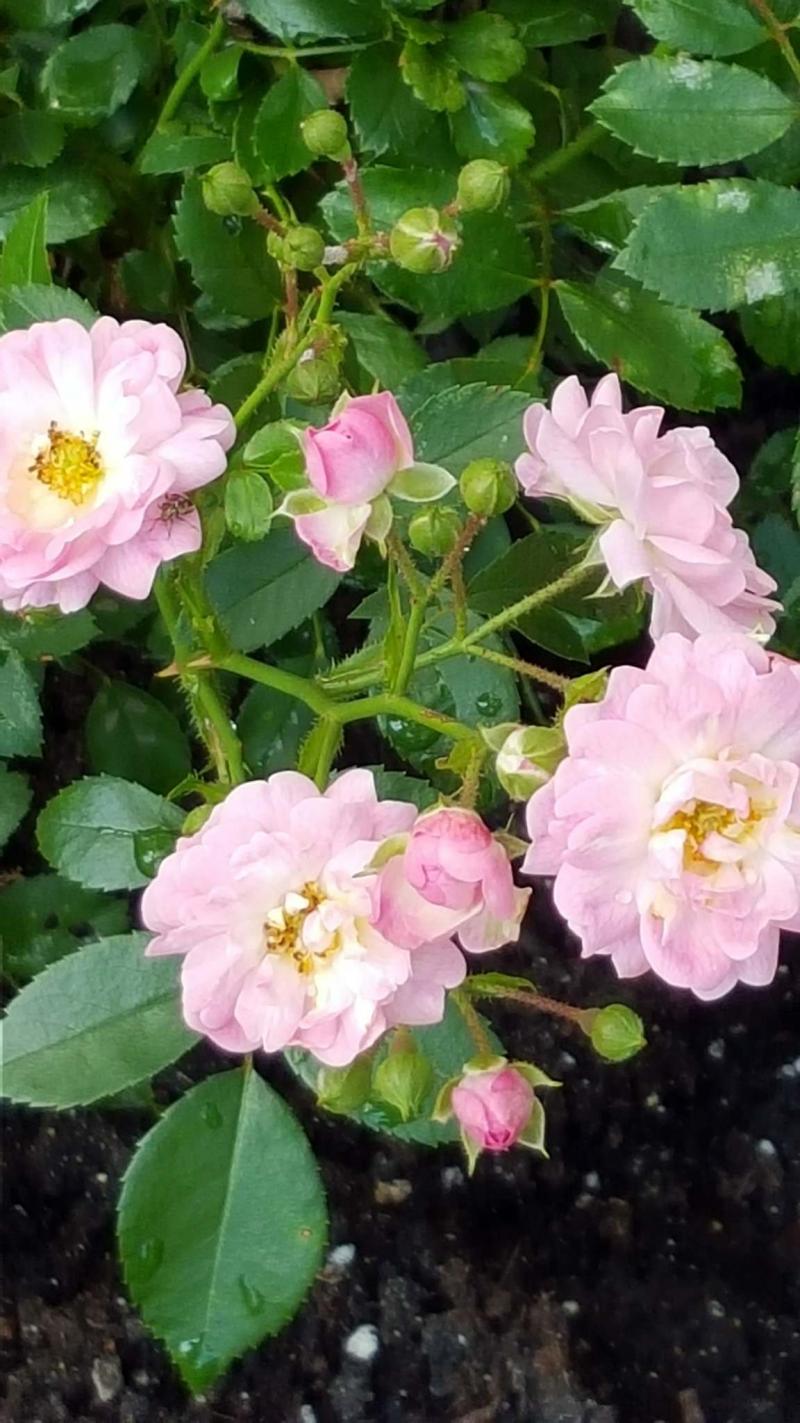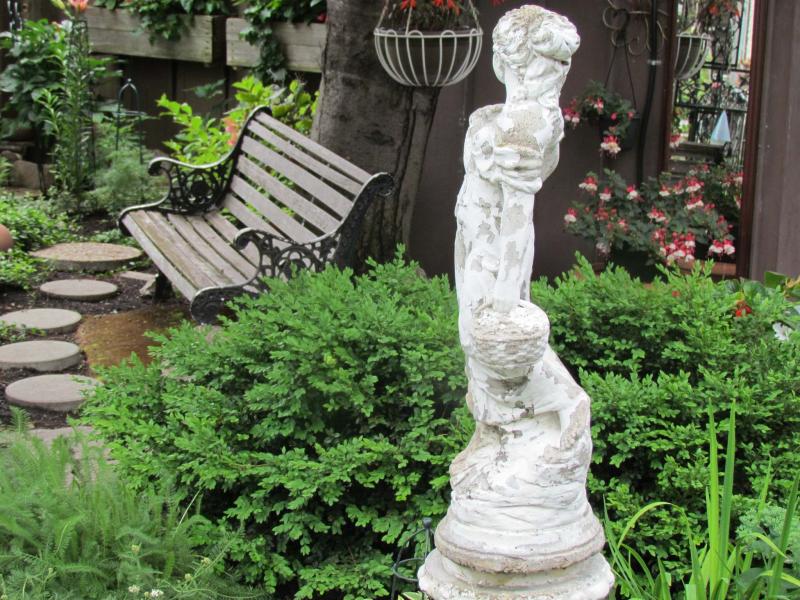
Colleen Zacharias
The Fairy rose, introduced in 1932, above, conceals its thorns with masses of pink blooms.

Colleen Zacharias
The key to growing boxwood, left, may be a location with afternoon shade and heavy snowcover.
Looking for solutions to challenges in your garden or suggestions for some new plants to try? Spend time in someone else’s garden, talking to the owner, and you are bound to come away with new perspectives or fresh inspiration.
Carole Young gardens in a quiet Transcona neighbourhood. She exudes a relaxed and confident approach towards her garden as well as a curious nature and receptivity to new ideas, all qualities of a successful gardener.
Young’s garden includes a wonderful diversity of flowering plants, vines, shrubs and annual container designs. Rather than the diminishing returns of a ground cover that consists mostly of lawn, Young has chosen to steadily increase the size of her flower beds so that her landscape is one of lushly planted herbaceous borders and curved pathways. A particularly attractive and functional potting area is located in the far corner of her backyard beneath the shade of a healthy Schubert chokecherry tree which also provides shade for a nearby pond. Filled with potted marsh marigold and King Tut papyrus, the pond teems with large goldfish that Carole brings indoors for the winter.
It was on a visit last summer to Young’s garden, when I first caught sight of the potting area — so inviting and well appointed – that I was intrigued to learn more about her gardening style and methods. A row of bell-shaped glass cloches sits on the ample countertop of the classic wooden potting bench. Pressed into service usually at the start of the growing season when nighttime temperatures drop sharply, the cloches act as miniature greenhouses for tender or struggling plants. A top hutch provides additional storage while a lower shelf serves as display space for shade-loving plants.
A tall, narrow wooden shed sits adjacent to the workbench. This is where Young stores small tools and supplies pertaining to the garden for ready accessibility. A larger utility shed a distance away houses heavier items. Raised beds on the perimeter of the work area overflow with an annual favourite, dragonwing begonias.
Accented by a unique cast-iron chair, one of the many iron accents throughout the garden, the work area is accessed by a winding pathway lined with a thick boxwood hedge planted in 1985. Typically, boxwood, an evergreen, can be subject to considerable winter browning. Consisting of three shrubs, Young’s boxwood hedge is in glowing health. Situated in an east exposure, the hedge receives morning sun and afternoon shade. Mounds of leaves at the base of the hedge together with an abundance of snow cover are all the protection afforded to the boxwood during the winter. Young ensures that the boxwood is well watered in the fall, key to ensuring that it goes into the winter with adequate moisture.
It was also in 1985 that Young’s Schubert Chokecherry tree was planted. The Young’s diligently prune out branches that exhibit the first signs of black knot fungus and the result is a handsome, leafy asset to their landscape. This spring forest tent caterpillars munched heavily on the tree’s foliage. Young removes any subsequent egg masses that she spots in the garden. According to Taz Stuart, entomologist, there are approximately 150 eggs per egg mass that will emerge next spring unless Mother Nature or a watchful gardener makes short work of them.
Young grows a variety of roses. Hardy varieties include Campfire with its multiple clusters of tri-coloured blooms, Morden Sunrise, Morden Blush, and the Never Alone rose. Last year her Never Alone rose was gorgeous with gleaming, healthy leaves. This year it is struggling. Young removes yellowing leaves as they appear. She plans to apply dormant oil as a spray in early spring before leaf buds show green at their tips. Dormant oil, so long as it is applied in spring when roses are dormant and temperatures are no cooler than minus 5 degrees C., can be effective as a defense against overwintering fungus. Scratching diatomaceous earth into the soil surface around roses acts as a natural pesticide against soilborne larvae (example, the dreaded rose sawfly which skeletonizes the leaves of roses).
The Fairy, a polyantha shrub rose that was first introduced in 1932, has put on a beautiful display this summer with masses of dainty pink roses. Particularly heavily thorned but wonderfully floriferous, Young has planted two specimens and says they bloom right up until the first light frost in fall, sometimes continuing to bloom until a hard frost.
After the harsh winter of 2014-2015, Young saw no signs of life last summer in one of her tender hybrid teas, a David Austin Windermere rose. Opting to leave the root ball in place, the rose made a surprising and dramatic appearance this spring. Now 90 cm tall, it is covered in beautiful blush coloured blooms.
Concerned about the effects of the prolonged high humidity and frequent rain-showers this summer, Young occasionally sets up an electric fan outdoors to increase air circulation around her roses and reduce the risk of fungal disease. She avoids the use of any overhead watering and amends her soil yearly with organic matter. An all-purpose 20-20-20 fertilizer provides added nutrients each spring. Young also feeds her plants with a tiny amount of water soluble fertilizer with each watering up until the August long weekend. She takes a leaner approach towards a large patch of Prickly Pear cactus which has grown in a bed adjacent to the foundation of her house for the past 40 years.
Young’s lilies are proof positive that the war against the scarlet lily leaf beetle can be fought and won. A combination of hand picking and squishing adult beetles, removing any signs of larvae on the undersides of leaves as well as the use of Sevin, a carbaryl-based insecticide, has been successful in reducing the beetle population, says Young.
Curiously, though, a number of Young’s lilies started out bright yellow but are now a brilliant orange. Sandra Venton, Winnipeg-based president of the North American Lily Society, says that likely as bulbs die off and seeds fall to the ground from spent blooms that remain on the plant, the new seedlings that result produce blooms that are a different colour.
Young grows numerous tender bulbs in her garden which she lifts in the fall and stores indoors for the winter. A fan of eucomis (pineapple lily), a distinctive plant that has strappy leaves and thick flower spikes with a crown of leafy bracts at the top, Young displays eucomis in pots in full sun, ensuring adequate space (eucomis dislikes crowding) and essential moisture.
Incarvillea, a tuberous plant, has been the most talked about plant in Young’s garden. Also known as hardy gloxinia, although not hardy in our climate, incarvillea is related to trumpet vines. Lengthy stems of deeply divided leaves and tubular mauve flowers with yellow throats make this an exciting plant which Young plans to have in her garden every year. Where did she find it? WalMart carried it this spring.
Another tender plant which Young is growing this summer and plans to lift in autumn is Hymenocallis narcissiflora Sulphur Queen. A sizeable plant also known as Peruvian daffodil, it grows to 55 cm with long, strap-like leaves, and produces large green striped trumpet-like blooms. Young grows the bulbs in the ground and in pots and has overwintered them indoors for the past four years.
Garden or fall mums that survived the winter the past few years have produced only late season buds just prior to frost. This year, to encourage an earlier flush of blooms, Young is covering them with a cardboard box at the recommendation of Ken Land, St. Mary’s Nurseries. Fall mums are short-day plants. By artificially controlling the day length, blooms may be possible.
In the meantime, Young achieved another, more important goal this summer. Despite her success with growing and overwintering passion flower vine (passiflora) – covered at times with up to 200 blooms – Young has struggled to grow sweet peas, a plant she says she is totally captivated by. Two years ago Young purchased Spencer giant mixture sweet pea seeds from McKenzie Seeds and decided on a new approach. In a sunny location, she dug a hole about 30 cm deep, added a bag of leaves mixed with soil, then added another layer of soil in which she planted the seeds. The plant produced stems and foliage last summer but no blooms. This year, however, her efforts have been rewarded with masses of sweet pea blooms. No perfume, though.
"That’s fine," she says, "maybe next year."
colleenizacharias@gmail.com



